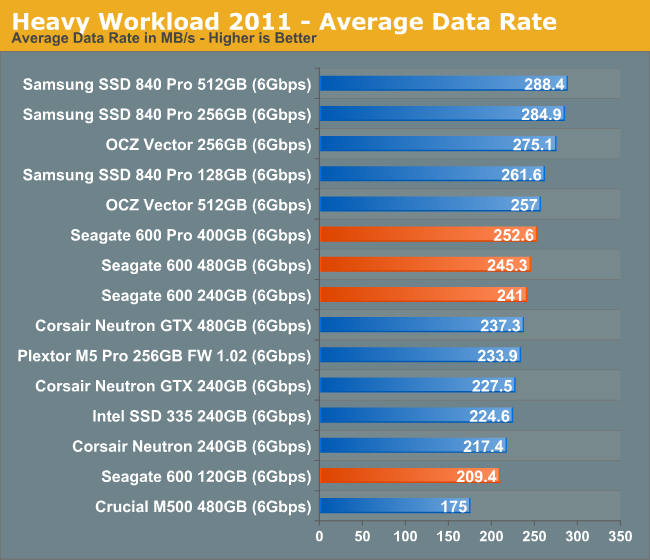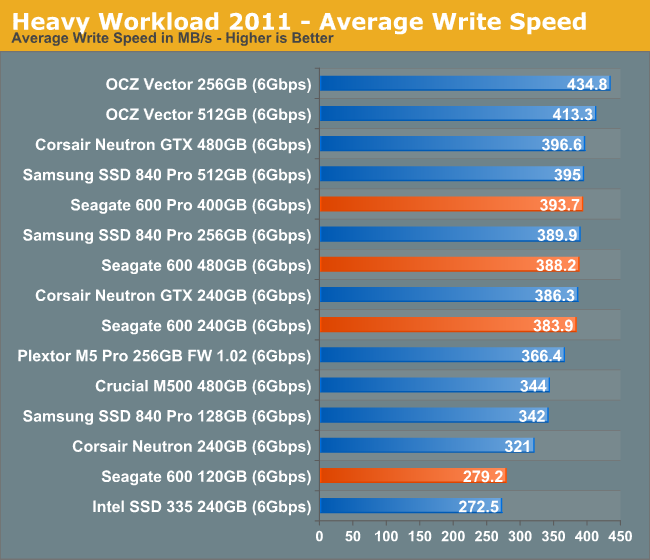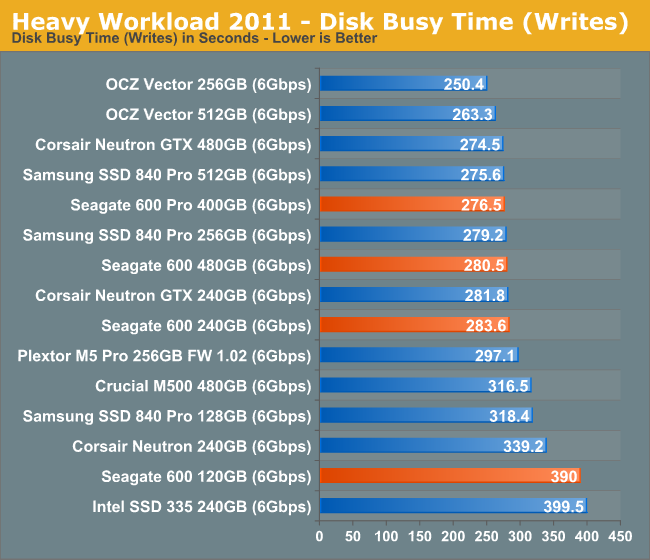The Seagate 600 & 600 Pro SSD Review
by Anand Lal Shimpi on May 7, 2013 8:00 AM ESTAnandTech Storage Bench 2011
Two years ago we introduced our AnandTech Storage Bench, a suite of benchmarks that took traces of real OS/application usage and played them back in a repeatable manner. I assembled the traces myself out of frustration with the majority of what we have today in terms of SSD benchmarks.
Although the AnandTech Storage Bench tests did a good job of characterizing SSD performance, they weren't stressful enough. All of the tests performed less than 10GB of reads/writes and typically involved only 4GB of writes specifically. That's not even enough exceed the spare area on most SSDs. Most canned SSD benchmarks don't even come close to writing a single gigabyte of data, but that doesn't mean that simply writing 4GB is acceptable.
Originally I kept the benchmarks short enough that they wouldn't be a burden to run (~30 minutes) but long enough that they were representative of what a power user might do with their system.
Not too long ago I tweeted that I had created what I referred to as the Mother of All SSD Benchmarks (MOASB). Rather than only writing 4GB of data to the drive, this benchmark writes 106.32GB. It's the load you'd put on a drive after nearly two weeks of constant usage. And it takes a *long* time to run.
1) The MOASB, officially called AnandTech Storage Bench 2011 - Heavy Workload, mainly focuses on the times when your I/O activity is the highest. There is a lot of downloading and application installing that happens during the course of this test. My thinking was that it's during application installs, file copies, downloading and multitasking with all of this that you can really notice performance differences between drives.
2) I tried to cover as many bases as possible with the software I incorporated into this test. There's a lot of photo editing in Photoshop, HTML editing in Dreamweaver, web browsing, game playing/level loading (Starcraft II & WoW are both a part of the test) as well as general use stuff (application installing, virus scanning). I included a large amount of email downloading, document creation and editing as well. To top it all off I even use Visual Studio 2008 to build Chromium during the test.
The test has 2,168,893 read operations and 1,783,447 write operations. The IO breakdown is as follows:
| AnandTech Storage Bench 2011 - Heavy Workload IO Breakdown | ||||
| IO Size | % of Total | |||
| 4KB | 28% | |||
| 16KB | 10% | |||
| 32KB | 10% | |||
| 64KB | 4% | |||
Only 42% of all operations are sequential, the rest range from pseudo to fully random (with most falling in the pseudo-random category). Average queue depth is 4.625 IOs, with 59% of operations taking place in an IO queue of 1.
Many of you have asked for a better way to really characterize performance. Simply looking at IOPS doesn't really say much. As a result I'm going to be presenting Storage Bench 2011 data in a slightly different way. We'll have performance represented as Average MB/s, with higher numbers being better. At the same time I'll be reporting how long the SSD was busy while running this test. These disk busy graphs will show you exactly how much time was shaved off by using a faster drive vs. a slower one during the course of this test. Finally, I will also break out performance into reads, writes and combined. The reason I do this is to help balance out the fact that this test is unusually write intensive, which can often hide the benefits of a drive with good read performance.
There's also a new light workload for 2011. This is a far more reasonable, typical every day use case benchmark. Lots of web browsing, photo editing (but with a greater focus on photo consumption), video playback as well as some application installs and gaming. This test isn't nearly as write intensive as the MOASB but it's still multiple times more write intensive than what we were running in 2010.
As always I don't believe that these two benchmarks alone are enough to characterize the performance of a drive, but hopefully along with the rest of our tests they will help provide a better idea.
The testbed for Storage Bench 2011 has changed as well. We're now using a Sandy Bridge platform with full 6Gbps support for these tests.
AnandTech Storage Bench 2011 - Heavy Workload
We'll start out by looking at average data rate throughout our new heavy workload test:

Seagate's 600 does reasonably well here, but if you don't take into account IO consistency then the 600/600 Pro are still behind Samsung's SSD 840 Pro.


The next three charts just represent the same data, but in a different manner. Instead of looking at average data rate, we're looking at how long the disk was busy for during this entire test. Note that disk busy time excludes any and all idles, this is just how long the SSD was busy doing something:













59 Comments
View All Comments
StealthGhost - Wednesday, May 8, 2013 - link
To me it was always just that HDDs are vastly different than SSDs. Making SSDs when you make HDDs is like starting from scratch almost. That is why the most random companies are making SSDs, because they made flash storage before. Corsair, OCZ, Crucial harddrives? I've owned RAM from all 3 but never a harddrive, but it makes sense for them to side step over from RAM to SSD, not so much for WD to go all the way down and then back up over to SSD.I hope WD becomes a big name in SSDs though, I have 5 WD harddrives that I can think of off the top of my head and one is from 2003. As you can tell, they're my favorite HDD manufacturer.
phillyry - Sunday, May 12, 2013 - link
Cactusdog, "I don't understand why Seagate and WD were so slow in the SSD market."Because they didn't want to destroy their reputations with a the shenanigans that was going on in the first couple gens of SSDs. They wisely waited until the tech was mature so that their multibillion dollar reputations wouldn't go down the drain.
Tams80 - Tuesday, May 7, 2013 - link
Same. I think around 500GB is the minimum I'd prepared to go with (for a laptop/mobile computer). They are still a bit too pricey and from my experience the hybrid drives, while good, aren't really worth it. 1TB would be great, but that will probably require waiting a few years.The 840 Pro looks to still be the best, but yes, it's still far too expensive for me. =(
klmccaughey - Tuesday, May 7, 2013 - link
The 240GB non Pro 840 is pretty good unless you are doing a lot of writing - very well priced.I have a 2TB HD and a 256GB Steam drive. With Steam Tool / or caching software that is plenty. My C drive is 2 x 128GB Vertex 3's in Raid 0.
Don't wait to switch! Just get what you can and add more when you can - you will never look back :)
MrSpadge - Tuesday, May 7, 2013 - link
Yeah.. just make smart use of the space you've got and you should be able to get by with much smaller SSDs than 500 GB. Personally using 64 GB to cache my 3 TB HDD - fast enough for me :)phillyry - Sunday, May 12, 2013 - link
The OP is talking about a mobile computer (laptop), not a desktop solution where you can have additional hard drives.creed3020 - Tuesday, May 7, 2013 - link
Seagate may be late to the game but wow what an entrance! Going with the LM87800 almost guaranteed a strong performer as we already know from the Corsair Neutron's history. Their own special sauce added to the firmware shows that they are taking this market seriously.The HDD manufacturers, glorious duopoly and all, need to see the writing on the wall and get some products into this market vertical. There will be a need for spinning platters for years to come still as 4TB SSDs are still a good ways out.
I'm currently on the fence for a Samsung 840 500GB but this announcement I need to wait and see how the reliability on these drives pans out as this may be the better choice.
Oxford Guy - Wednesday, May 8, 2013 - link
MLC drives are generally going to be more reliable than TLC drives, unless you're dealing with firmware bugs (like the horribly buggy 1st generation Sandforce controller in the Vertex 2e)name99 - Wednesday, May 8, 2013 - link
"Seagate may be late to the game but wow what an entrance!"To me this is in the interesting point. Presumably Seagate are interested in surviving for more than the next five years. Which means they have to be in the broadly defined storage business, not just the HD business. Which in turn means: raises the question --- presumably they want to be the equivalent in the flash business of their role in the HD business?
What would that take? If they were doing it seriously, it would take
(a) own the controller. It seems they already own the firmware. Perhaps they don't care much about the LAMD/Hynix link because the next step is to design their own controller?
(b) fab the flash. Until they do that, as has been said, they're just one of a dozen assemblers. Of course fabbing flash is not a completely trivial business to get into... So --- buy Hynix (or someone else)? Or not the whole company, but at least the flash division? I suspect we will see something like this.
If they DO own the firmware, the chip, and the flash, they are at least in a rather better position.
They can start to apply real engineering to these devices in a way we haven't yet seen, most obviously in much better power performance, both idle power and peak random writes power. There may also be scope for other innovations once you own the entire pipeline, for example you can tweak the flash being fabbed for a more precise set of specs, or you can drive it to tend to certain (known) failure modes which your firmware is set up to work around.
JellyRoll - Tuesday, May 7, 2013 - link
Corsair recently released new versions of the Neutrons with a die shrink, are these Neutrons compared in the article with the new NAND?